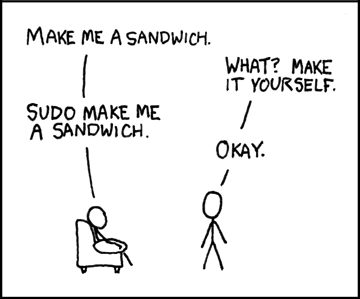本文为转帖,是在学习的时候搜索到的,现在收藏下,但是来源必须得标示出来:
http://www.garron.me/en/linux/visudo-command-sudoers-file-sudo-default-editor.html
The sudoers file located at: /etc/sudoers, contains the rules that users must follow when using the sudo command.
If you have ever used used Ubuntu, you know that the root account is disabled. This is because the root password is not set in Ubuntu, you can assign one and use it as with every other Linux distribution. That anyway is another story. On normal Ubuntu Linux computers you need to use sudo to act as root.
I like using sudo, I’m not using Ubuntu anymore. The first thing I do when I install a new Linux is to use visudo to edit the sudoers file. And I always give my account root rights, then I can run commands as root without switching users.
The best way to understand the sudo command, and the rules in sudoers file, the funny way is by this comics.

credit to: XKCD
As you can see from this funny picture, using sudo command, makes the system obey any given order.
The two best advantages about using sudo command are:
- Restricted privileges
- Logs of the actions taken by users
I’m sure you are now fully aware of the advantages of using sudo command in a daily basis, how to use it?
In order to use sudo you first need to configure the sudoers file. The sudoers file is located at /etc/sudoers. And you should not edit it directly, you need to use the visudo command.
Once you enter visudo command, you will see something like this:
# /etc/sudoers
#
# This file MUST be edited with the 'visudo' command as root.
#
# See the man page for details on how to write a sudoers file.
#
Defaults env_reset
# Host alias specification
# User alias specification
# Cmnd alias specification
# User privilege specification
root ALL=(ALL) ALLAlmost all lines are commented out, the one that matters in this sudoers file example is:
root ALL=(ALL) ALLThis line means: The root user can execute from ALL terminals, acting as ALL (any) users, and run ALL (any) command.
The first part is the user, the second is the terminal from where the user can use sudo command, the third part is which users he may act as, and the last one, is which commands he may run when using sudo.
sudoers examples
operator ALL= /sbin/poweroffThe above command, makes the user operator can from any terminal, run the command power off.
You can also create aliases for: users -> User_Alias, run commands as other users -> Runas_Alias, host -> Host_Alias and command -> Cmnd_Alias
User_Alias OPERATORS = joe, mike, jude Runas_Alias OP = root, operator Host_Alias OFNET = 10.1.2.0/255.255.255.0 Cmnd_Alias PRINTING = /usr/sbin/lpc, /usr/bin/lprmAs you can see the alias OPERATORS includes the users joe, mike and jude, the alias OP includes the users root and operator, alias OFNET includes the network 10.1.2.0 (all the C class), and the command alias PRINTING includes the commands lpc and lprm.
So, a typical sudoers file may look like this:
User_Alias OPERATORS = joe, mike, jude
Runas_Alias OP = root, operator
Host_Alias OFNET = 10.1.2.0/255.255.255.0
Cmnd_Alias PRINTING = /usr/sbin/lpc, /usr/bin/lprm
OPERATORS ALL=ALL
#The users in the OPERATORS group can run any command from
any terminal.
linus ALL=(OP) ALL
# The user linus can run any command from any terminal as any
user in the OP group (root or operator).
user2 OFNET=(ALL) ALL
# user user2 may run any command from any machine in the
OFNET network, as any user.
user3 ALL= PRINTING
# user user3 may run lpc and lprm from any machine.
go2linux ALL=(ALL) ALL
# user go2linux may run any command from any machine acting
as any user. (like Ubuntu)If you want not to be asked for a password use this form:
go2linux ALL=(ALL) NOPASSWD: ALLYou may want to read sudoers man page
Considering that you are still reading here a bonus:
visudo command uses vi as the editor here some tips to use it:
- Switch to root, (su root), then run visudo, (as above).
- Find where it says “root ALL=(ALL) ALL”.
- Type “o” to insert a new line below it.
- Now type what you want to insert, eg “username ALL=(ALL) ALL”.
- Hit esc to exit insert-mode.
- Type “:x” to save and exit.
Can I change the default visudo editor?
Yes, changing the default visudo editor is easy.
And just because of your dedication, and still reading until here, I’ll show you how to set nano or vim to use with visudo command as default editor.
Using vim with visudo
export VISUAL=vim; visudoUsing nano with visudo
export VISUAL=nano; visudo








相关推荐
- 举例来说,可以使用网易163源,这些源通常提供更快的下载速度。 - 修改方法是先注释掉原有源,然后添加新的国内源地址,例如网易163源。 #### 四、Linux目录结构 - Debian系统的目录结构遵循标准的Linux文件...
分成两个分卷进行压缩 ...12.2.5 sources.list配置文件 325 12.3 利用aptitude管理软件包 327 12.3.1 安装软件包 329 12.3.2 系统的升级 330 12.3.3 查询软件包 330 12.3.4 检索软件包 330 12.3.5 删除软件包 ...
分成两个分卷进行压缩 ...12.2.5 sources.list配置文件 325 12.3 利用aptitude管理软件包 327 12.3.1 安装软件包 329 12.3.2 系统的升级 330 12.3.3 查询软件包 330 12.3.4 检索软件包 330 12.3.5 删除软件包 ...
文档中举例了如何用`visudo`命令安全地编辑sudo配置文件,这个文件位于`/etc/sudoers`。通过修改该文件,可以配置普通用户拥有某些特殊权限,如添加用户、修改用户密码等。同时,文档也提及了使用`sudo -l`命令来...
举例来说,要切换到root用户并执行`ls`命令,你可以使用`su -c "ls"` root。若不希望改变环境变量,可以使用`su -p` postgres切换到postgres用户。 接下来是`sudo`命令,它允许非root用户以root或其他特定用户的...